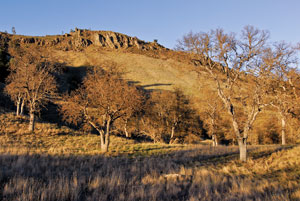
I set down my lunch-time burrito to answer my cell phone. It was a friend cancelling our late afternoon appointment. A moment later, it dawned on me. With that cancellation, I now had two wide open days in front of me. My emotional rope had developed a couple knots, and my head needed clearing. Here was an opportunity for the perfect therapy.
I packed like a minor leaguer just called up to the majors and hit the road. As a Coe Park volunteer working on a project in the backcountry, I was able to get permission to enter the park near Bell’s Station on Pacheco Pass. If you have been lucky enough to see this part of Coe Park, you know that this is where the park really sings. Here, the rugged chaparral-choked country to the west relaxes into a soft rolling blue oak savannah. This is not the wilderness where one struggles against nature’s awesome forces. This is friendly country where the wind is always gentle and at your back.
Most of the rain that falls in the western portion of the park collects in streams that ultimately join forces to become Coyote Creek bound for the San Francisco Bay. On the east side, rainfall runs into the South Fork of Orestimba Creek and flows the other direction, toward the Central Valley. I decided to follow Orestimba Creek from its source to the Rooster Comb, a beautiful geologic feature seven miles down stream.
Most of this route is over Orestimba Creek Road, but I began on Orestimba Creek Trail, a 2-mile foot path etched into the hill above the creek. Just a couple hundred yards down the trail, I noticed a lovely rock outcrop in a sunny spot next to the creek. Someone once told me that a place such as this – an inviting creekside rock outcrop – is likely to have been recognized by Native American women as a great place to grind acorns and chat with friends. Sure enough, I found several grinding holes. Not that long ago, they sat right here, talking, laughing, and doing their chores.
The trail rejoined the road and I continued my way down Orestimba Creek. Steep trails are the rule near park headquarters, but here gravity barely whispers. I rolled through soft grassy slopes dotted with blue oaks. Even the names of the features – Mustang Flat, Paradise Flat – hint at the easy terrain. I took side trips to Kingbird Pond, Mustang Pond and Paradise Pond, each about a half mile from the road. I inspected another likely creekside rock outcrop and found more grinding holes.
The sun was getting low in the west when I reached the wide open basin beneath the Rooster Comb. I unrolled my bag and prepared a quick dinner. Sunset would soon light up the Rooster Comb, and I wanted to be ready to wander the lower slopes in search of a nice photograph.
This part of Henry Coe State Park is simply magical. It is waiting there for all to see, but at a high physical cost. From park headquarters above Morgan Hill, the Rooster Comb is a very ambitious two-day, and more likely a three-day, walk. But one weekend a year, the Pacheco Pass entrance to the park is open to visitors where volunteers can shuttle you to the very edge of this country. Space is limited, and applications must be sent in advance. This year’s deadline has passed, but mark your calendar to go to www.coepark.org next February. Behind the “Backcountry Weekend” tab is the application form and all the details.







